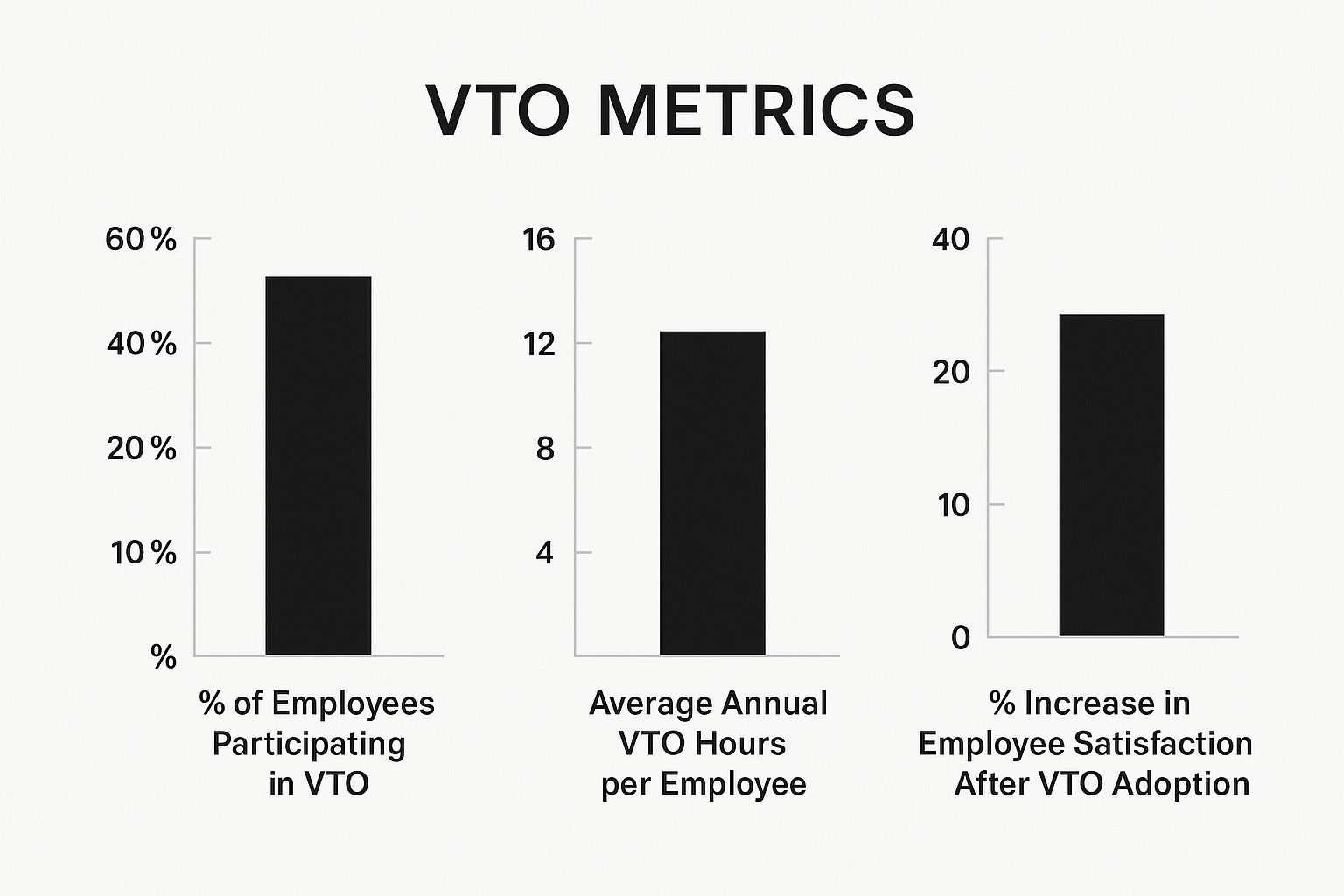Voluntary Time Off (VTO) Guide: Boost Employee Flexibility

Voluntary Time Off (VTO) is becoming increasingly popular in India. Companies are recognizing the importance of flexibility in the modern workplace. This shift is largely due to changing workforce demographics. Millennials and Gen Z employees have different priorities when it comes to work-life integration.
These younger generations value personal well-being. They often seek out employers who offer flexible work arrangements. This is prompting companies to rethink their traditional leave policies. Alternatives like VTO are gaining considerable attention. But how does VTO function within the Indian workplace?
Defining VTO in the Indian Context
The concept of VTO in India might not mirror its Western counterpart exactly. However, it’s closely tied to flexible work arrangements and employee benefits. Indian employees are increasingly seeking flexibility in their schedules.
According to a Randstad India survey, 60% of employees would reject a job without flexible working hours. Another 56% would decline roles lacking flexibility in work location. This highlights a significant trend. Employees prioritize work-life balance and desire greater control over their schedules. This reflects a growing demand for arrangements similar to VTO. For more detailed statistics, check out this article: Five in 10 Indian Employees Willing to Leave Jobs That Don’t Offer Flexibility
Addressing the Challenges of India’s Workforce
Traditional leave structures struggle to meet the unique needs of India’s diverse workforce. Factors such as festival seasons, extended family commitments, and regional differences in work-life balance create complexities. Standard leave policies often fail to address these adequately.
VTO offers a potential solution. It provides a more personalized and adaptable approach to time off. This flexibility helps employees manage their time effectively. They can better align their work schedules with personal needs and cultural obligations.
The Transformative Power of VTO
VTO is more than just a cost-saving strategy. It’s a tool for reshaping workplace culture. By giving employees more control over their time, organizations build trust and autonomy. This boosts morale and increases engagement.
These improvements can lead to tangible benefits. Reduced burnout, higher productivity, and improved employee retention are all possible outcomes. For insights on desirable workplaces, see: Best Companies to Work For. VTO is an investment in a more engaged and productive workforce, creating a positive impact across the organization.
Building the Business Case for VTO Implementation

While some Indian businesses might initially hesitate to embrace Voluntary Time Off (VTO), many are quickly recognizing its potential advantages. This section explores the compelling Return on Investment (ROI) of VTO and how it can positively affect your bottom line. This positive impact ranges from decreased turnover and recruitment expenses to substantial improvements in productivity.
Addressing India’s Engagement Crisis With VTO
A significant challenge facing Indian businesses is the growing engagement crisis. This issue is costing companies millions in lost productivity and reduced efficiency. In recent years, workforce engagement in India has declined, with levels falling to 19% in 2025. This drop is partly attributable to the lack of flexibility and personalized benefits that resonate with employees’ values and needs.
The demand for flexible work arrangements, similar to VTO, is rising as employees seek a better work-life balance. VTO can directly address this crisis by offering employees much-needed flexibility and control over their schedules. This empowers employees to better manage their commitments, leading to greater job satisfaction and improved well-being. For more information, see these statistics: India Workforce Engagement Plummets to 19 Percent in 2025.
The Financial Benefits of VTO
This improved job satisfaction translates directly into financial gains for organizations. VTO programs can significantly reduce employee turnover, saving companies substantial costs associated with recruiting, hiring, and training. A more engaged workforce is also a more productive one. VTO can contribute to increased productivity by mitigating burnout and allowing employees to return to work feeling refreshed and motivated.
Building a Strong Case for VTO
Implementing VTO requires careful planning and a strong business case. It’s crucial to develop a cost-benefit framework specific to Indian business realities. This framework should clearly outline potential cost savings from reduced turnover and increased productivity.
It’s also important to emphasize the less tangible but equally vital benefits, such as a better employer brand and improved employee morale. A strong business case can secure executive support and pave the way for successful VTO implementation. For guidance on employee attrition and prevention strategies, explore this helpful resource: Read also: An Overview of Employee Attrition and How to Prevent It. By addressing employee needs through VTO, companies create a more sustainable and productive environment while saving money. Real-world examples of Indian organizations demonstrate VTO’s success, showcasing tangible benefits like reduced sick leave abuse and a stronger employer brand in competitive talent markets. By demonstrating a clear ROI and addressing specific business challenges, companies can effectively advocate for VTO and realize its full potential.
Navigating Legal Compliance and Regulatory Framework

Implementing a Voluntary Time Off (VTO) program in India requires careful attention to the country’s labor laws. This section offers guidance on creating VTO policies that meet legal requirements, ensuring compliance, and avoiding potential problems. Understanding these regulations is essential for a successful VTO program.
Aligning VTO with the Indian Labor Code
The Indian Labor Code brings together a number of different labor laws. This consolidation affects how VTO policies should be designed. It’s crucial to ensure VTO policies don’t violate rules around working hours, wages, and leave. A well-written policy should clearly state that VTO is truly voluntary and doesn’t put indirect pressure on employees.
State-Specific Regulations and the Factories Act
VTO policies must also comply with state-specific rules and the Factories Act, 1948. This is particularly important for businesses involved in manufacturing. These regulations govern working hours and required breaks. A VTO policy needs to work with, not against, these rules.
Industry-Specific Considerations for VTO
Different industries have their own unique needs. For example, the IT sector often has more flexible work arrangements than manufacturing, which needs to stick to stricter shift schedules. VTO policies should be adapted to fit the specific requirements and legal frameworks of each industry.
In IT, VTO might be easier to implement because of the prevalence of remote work and flexible hours. However, in manufacturing, VTO needs careful management to avoid disrupting production and shift patterns.
Documentation, Union Negotiations, and Compliance Checkpoints
Good documentation is key. A clear VTO policy document should outline all the terms and conditions. This creates transparency and protects both the employer and the employees. In companies with unions, discussions and agreement are critical. This ensures the VTO policy works for everyone and fits with existing collective bargaining agreements. Check out our guide on How to master high-impact hiring driven by data. Regular compliance audits and reviews are also recommended. This proactive approach helps spot and fix potential legal problems early on.
A successful VTO program requires not only clear policies but also a solid understanding of the legal landscape. By carefully considering the Indian Labor Code, state-specific regulations, and industry needs, businesses can create VTO programs that benefit both employees and the company while staying legally compliant. This focus on legal compliance builds a strong base for the long-term success of the VTO program.
Designing VTO Policies That Actually Work

The infographic above illustrates key VTO metrics. These include employee participation rates, average annual VTO hours used, and the impact of VTO on employee satisfaction. The data suggests that a well-structured VTO policy can significantly increase employee satisfaction. At the same time, it can also achieve high participation rates and maintain reasonable usage. This highlights the importance of designing VTO policies that balance employee needs and operational requirements.
Building a Framework for Success
A successful Voluntary Time Off (VTO) program requires a well-defined framework. Simply allowing employees to take unpaid time off isn’t enough. The framework should address India’s specific workplace dynamics. This includes navigating challenges like monsoon season disruptions and major festival periods.
For instance, during Diwali or Holi, companies might see higher demand or reduced staffing. This is often due to travel and celebrations. A robust VTO policy should anticipate these fluctuations. It should also provide guidelines for managing time-off requests during these periods.
Key Policy Considerations
- Advance Notice: VTO policies should specify how much advance notice employees need to provide. This helps managers plan and ensure adequate coverage. Two weeks is common, but this can vary.
- Peak Season Coverage: Many companies, especially in retail or hospitality, have peak seasons. Policies must address staffing during these crucial times. This might involve restricting VTO during specific dates or using a quota system.
- Preventing Policy Abuse: Clear guidelines are essential to prevent policy misuse. This might include setting a maximum number of VTO days allowed per year or quarter. The policy should also outline the consequences of not following procedures.
VTO Models for Different Organizations
There’s no one-size-fits-all VTO policy. Different models work better for various organizations. A smaller company might use a simpler, more flexible approach. Larger organizations might need more structured systems. They might even use online platforms like BambooHR for managing requests and approvals.
Different industries also have unique needs. For example, IT, with its project-based work, will have different requirements than manufacturing. Production schedules play a vital role in manufacturing. Offering various models ensures flexibility and customization while maintaining fairness and transparency.
The following table compares different VTO policy models suitable for Indian organizations:
VTO Policy Models Comparison
| Policy Type | Best For | Implementation Complexity | Employee Response | Business Impact |
|---|---|---|---|---|
| Flexible/Informal | Small companies, startups | Low | Generally positive, potential for inconsistencies | Can be disruptive if not managed carefully |
| Structured/Formal | Larger organizations, companies with fluctuating demand | Medium | Can feel restrictive, but provides clarity | More predictable impact on operations |
| Seasonal/Project-Based | Industries with peak seasons or project-based work | High | Can be well-received if aligned with business needs | Minimizes disruption during critical periods |
| Hybrid | Adaptable to various organizational needs | Medium to High | Depends on the specific combination of approaches | Can balance flexibility and control |
This comparison highlights the importance of choosing a VTO policy that aligns with the specific characteristics of your organization. A thoughtful approach will lead to a successful and beneficial VTO program.
Customizing Your VTO Policy
The best VTO policies are tailored to your business. Here are some factors to consider:
- Industry Norms: Researching what competitors and similar companies offer is helpful. This provides a benchmark and helps you design a competitive VTO policy.
- Company Culture: Your VTO policy should reflect your company culture. A generous policy reinforces a company that values work-life balance.
- Employee Feedback: Involve employees in policy development. This ensures buy-in and addresses their needs. Surveys, focus groups, and discussions provide valuable input.
By considering these factors, your VTO program can improve employee morale and boost retention. This creates a supportive and productive work environment. A well-designed VTO policy shows respect for employees’ time, strengthening company culture and employee relations.
Strategic Implementation and Change Management
Successfully launching a Voluntary Time Off (VTO) program in India requires a strategic approach. It’s more than just announcing a new policy; it’s about managing change within the specific context of the Indian workplace. This involves understanding employee perspectives and building a supportive environment for VTO adoption.
Communication Strategies for Diverse Teams
Effective communication is the cornerstone of successful VTO adoption. However, different employee segments respond to different communication styles. For example, tech-savvy millennials might prefer digital announcements and online resources, while experienced professionals might value in-person meetings and detailed explanations.
Therefore, a multi-channel communication strategy is essential. This could include emails, presentations, Q&A sessions, and even internal social media posts. The core message should emphasize the benefits of VTO for both the employee and the organization, clearly explaining how VTO aligns with company values and supports work-life balance.
Empowering Managers to Handle VTO
Managers are pivotal in VTO implementation. They approve requests, ensure fair policy application, and manage team workloads. Therefore, equipping them with the right training is crucial. They need to understand the VTO policy thoroughly, the procedures for handling requests, and strategies for maintaining productivity.
Training should also address potential biases, emphasizing consistent and fair decision-making. Providing managers with tools and resources to effectively plan and adjust workloads based on VTO usage is also key.
Building Leadership Support and Transparency
Strong leadership support is crucial for a successful VTO rollout. Leaders should actively champion the program and communicate its value to their teams. This top-down approach reinforces the importance of VTO and encourages its use.
Transparency is equally important. Employees should have easy access to the VTO policy, procedures for requesting time off, and information on how VTO is tracked. This builds trust and addresses potential anxieties about misuse or unfairness.
Addressing Potential Pitfalls
While VTO offers numerous benefits, challenges can arise. Some employees might hesitate to use it, concerned about how it will be perceived. Others might worry about career progression or team workload impacts.
Addressing these concerns proactively is crucial. Openly discuss the benefits of VTO and reassure employees that using the program will not negatively affect performance evaluations or career advancement. Sharing success stories of employees who have used VTO effectively can also be beneficial.
Step-by-Step Rollout and Measurement
A phased rollout can facilitate smoother implementation. Starting with a pilot program in a specific department or team allows for testing the policy, gathering feedback, and making adjustments before company-wide implementation.
Tracking key metrics is essential for measuring program success. Monitoring VTO usage rates, employee satisfaction, and any impact on productivity provides insights into program effectiveness and identifies areas for improvement. By following this structured approach, organizations can implement VTO effectively and realize its benefits, including reduced turnover, higher engagement, and a stronger employer brand.
Measuring Success and Optimizing Performance
Effective Voluntary Time Off (VTO) programs require ongoing monitoring and improvement to ensure sustained value for both employees and the organization. This goes beyond simply tracking VTO usage; it involves establishing Key Performance Indicators (KPIs) that reveal the program’s true effectiveness. This section explores how to measure success and optimize your VTO program for maximum impact.
Key Performance Indicators (KPIs) for VTO Success
Measuring your VTO program’s success requires a data-driven approach. Here are some essential KPIs to consider:
- Employee Participation Rate: This metric tracks the percentage of eligible employees using VTO. A higher rate suggests the program meets employee needs and is accessible.
- Average VTO Hours Taken: Tracking average VTO hours per employee offers insights into usage patterns, helping determine if VTO is used for short breaks or extended time off.
- Employee Satisfaction: Regular surveys can assess VTO satisfaction and its impact on work-life balance. Gather feedback on ease of use, fairness, and overall experience.
- Impact on Productivity: Analyze productivity before and after VTO implementation, including metrics like output, project completion rates, or sales performance. This helps determine VTO’s effect on productivity.
- Cost Savings: Track cost savings from reduced overtime or temporary staffing, quantifying VTO’s financial benefits and demonstrating its organizational value.
Data Collection and Analysis
Gathering KPI data requires various methods, from tracking VTO requests through your HR system to conducting employee surveys. Respecting employee privacy is crucial. Anonymize data where appropriate, using it solely for program evaluation. Tools like surveys offer anonymous feedback options.
For example, use pulse surveys for regular feedback on VTO experiences. Analyze VTO usage patterns to identify trends and improvement areas. The Indian government explores time use and work patterns through surveys like the 2024 Time Use Survey. This research sheds light on Indian work culture and time management, indirectly influencing the need for flexible arrangements like VTO. Learn more about these insights here.
Optimizing VTO Policy Based on Data
Collected data provides valuable insights for improvement. Low employee participation might require reevaluating communication or simplifying the application process. VTO overuse in certain departments might indicate workload issues.
The following table presents a VTO Success Metrics Dashboard:
To effectively track and optimize your VTO program, consider the key metrics and their measurement methods outlined in the table below. This dashboard serves as a valuable tool for ongoing monitoring and evaluation, empowering data-driven decisions.
VTO Success Metrics Dashboard Key performance indicators for measuring VTO program effectiveness in Indian organisations
| Metric | Measurement Method | Target Range | Review Frequency |
|---|---|---|---|
| Employee Participation Rate | HR system data | 50-70% | Quarterly |
| Average VTO Hours Taken | HR system data | 8-12 hours/employee/year | Quarterly |
| Employee Satisfaction | Employee surveys | 4.0+ (on a 5-point scale) | Bi-annually |
| Impact on Productivity | Performance data | Maintain or increase productivity | Quarterly |
| Cost Savings | Payroll and budget data | Variable, based on organizational goals | Annually |
This dashboard provides a framework for ongoing monitoring and evaluation, enabling data-driven decisions to optimize your VTO policy and maximize its effectiveness.
Are you ready to prioritize workplace flexibility and employee well-being? Visit Taggd to explore our Recruitment Process Outsourcing solutions for attracting and retaining top talent.
